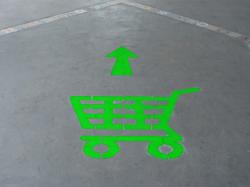Study: Arrows On Grocery Floors Increased The Proportion Of Produce Spending
July 5, 2016 | 1 min to read

Fruit and vegetable availability is often assumed to be a purchase barrier, yet fruit and vegetable availability does not necessarily result in frequent purchases. Rather, in-store marketing of less-healthy foods may be a major influencing factor in consumer spending habits regarding fruits and vegetables. A new study, in which in-store marketing focused attention on fruits and vegetables, resulted in an increased proportion of produce purchases keeping overall food spending the same.
To study the effect of in-store marketing, researchers used a shopper marketing nutrition intervention and placed 10 large (6 by 3 feet) green arrows on the floor of a grocery. The arrows were placed in highly visible areas around the perimeter of the store and pointed to the produce section. On the arrows were sayings such as, "Follow green arrow for health," and included a graphical representation of fruits and vegetables and emoticons to facilitate social approval.
Two groceries were included in this pilot study, including a control grocery of the same chain with similar demographics and poverty levels with no arrows. Weekly sales reports detailing daily grocery department sales were generated by the retailer for the 14-day trial. During this period, the intervention store experienced a significant increase in the proportion of spending on produce compared with other food. Despite the increase in spending on fruits and vegetables at the intervention store, however, the total food spending per customer did not change significantly between the two stores
To read the rest of the story, please go to: Elsevier Health Sciences
